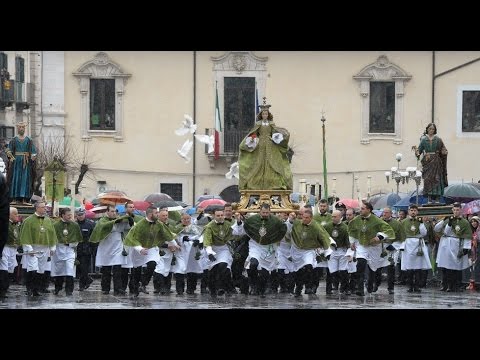Virgem Maria correndo para Jesus
NOSSA SENHORA CORRENDO? Sim! Pois grande é sua alegria ao ver o Filho ressuscitado! Isso acontece na ocasião da Páscoa, em uma festividade na cidade italiana de Sulmona. Quando ela avista Jesus ao longe, seu manto negro de luto cai, e 12 pombas se põe a voar. Essa é uma tradição secular realizada pela irmandade de Santa Maria de Loreto. Run, Madonna! Run!
Posted by O Catequista on Wednesday, 30 March 2016
The above video is explained by Anthony Parente
On Easter Sunday the ancient city of Sulmona, which is located in the Abruzzo region, reenacts that moment when Mary sees her resurrected son Jesus for the first time. The celebration is appropriately called La Madonna che scappa in piazza (Our Lady running in the Square) and it has been a tradition that the town of Sulmona has celebrated since the 18th century.
For the people of Sulmona Holy Week is a culmination of events that led up to Easter Sunday and the ceremony of La Madonna che scappa in piazza. The Confraternity of Santa Maria di Loreto, which oversees the events, meets on Holy Monday and they select the names of the four people that will be in charge of the running of Our Lady of Sorrows, which is one of the highest honors bestowed on a citizen of Sulmona. Following the selection prayers and vigils take place each night leading up to Good Friday.
On Good Friday the city of Sulmona celebrates the Passion of our Lord. This is when the crucifix is brought down and all those in attendance kiss the crucifix and then attend mass. A procession occurs after the mass in the streets and it includes the statue of Christ on top of a casket which is covered in white. Followed behind is the statue of the Madonna dressed in black carrying a white handkerchief in her right hand, which is a symbol of sorrow.
On Holy Saturday the statue of the Madonna is taken from the Santa Maria della Tomba church to the Church of San Filippo Neri where the statue will remain overnight. A bonfire is lit in the center of the square and the fire is used to light the Pascal Candle which is placed on the altar. At midnight the bells are rung signifying the resurrection of our Lord.
A procession takes place on Easter Sunday and the statue of the risen Christ is placed under one of the arches in Garibaldi Square on the opposite side from San Filippo Neri church. Then the statues of St. Peter and St. John are taken to San Filippo Neri church so they can tell Mary the good news. They knock on the door of the church and tell Mary that Jesus has risen, but she does not believe them and refuses to come out. St. John knocks again and tells her that Jesus is waiting at the opposite side of the square. Mary finally believes St. John and the doors open and the statue is carried out of the church and slowly makes its way across the square. Once it reaches the fountain in the middle Mary sees Jesus and starts to run to him. The black dress a symbol of sorrow falls off and Mary is wearing a green dress which symbolizes life and good omen. The white handkerchief is gone and a red rose a symbol of love is in her hand and 12 doves are released and fly in the sky representing the 12 apostles. Those selected to carry the statue of Mary start to run until they get to the arch where Jesus is.
There is, of course, no account in the scriptures of the Risen Jesus appearing to Mary, his mother. There are differing conjectures about this.
St Ignatius Loyola, for example, assumes the Risen Jesus appeared to his mother, and places this as the first of Christ’s appearance meditations in his Spiritual Exercises:
OF THE RESURRECTION OF CHRIST OUR LORD OF HIS FIRST APPARITION
First Point. First: He appeared to the Virgin Mary. This, although it is not said in Scripture, is included in saying that He appeared to so many others, because Scripture supposes that we have understanding, as it is written: “`Are you also without understanding?”`
Below, is this year’s running of Our Lady. You can see St John arriving to tell Mary around 36:00. The running occurs around 49:00
I hope, if you appreciated this post today, that you share it (facebook and so on). And do remember to like the liturgy facebook page, use the RSS feed, and sign up for a not-very-often email, … And if you enjoyed the April Fools post, you can, of course, look up previous years by using the Archive of Posts date on the right-hand column.
If you appreciated this post today, remember to like the liturgy facebook page, use the RSS feed, and sign up for a not-very-often email, …



